Guide to Scalable Ethereum Restaking for DeFi
As decentralized finance (DeFi) projects continue to grow, the need for scalable and secure infrastructure becomes paramount. Ethereum’s transition to Proof-of-Stake (PoS) has opened the door to innovative solutions like Ethereum Restaking, a mechanism that can significantly enhance the security and performance of DeFi applications. Ethereum Restaking allows projects to use staked ETH to participate in securing Ethereum’s consensus layer while simultaneously enabling additional value generation for DeFi projects.
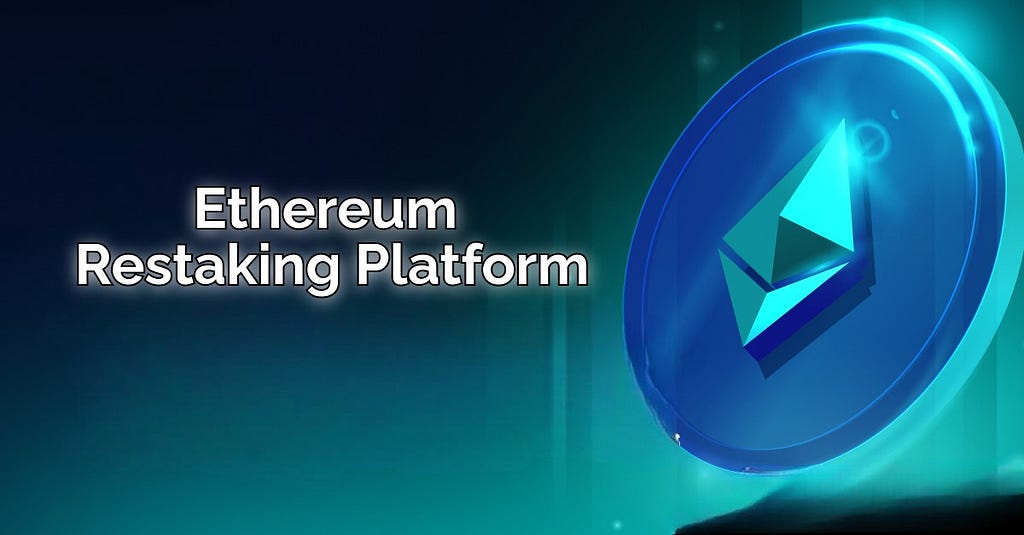
For DeFi developers, building a scalable restaking platform is a crucial step in ensuring the sustainability and growth of their decentralized applications (dApps). By implementing efficient staking and restaking strategies, projects can improve network security and yield, all while enhancing user participation. In this blog, we will explore the essential steps involved in building a scalable Ethereum restaking platform tailored for DeFi applications. From selecting the right infrastructure to incorporating layer-2 scaling solutions, we’ll delve into best practices and strategies that can help DeFi projects stay ahead in a rapidly evolving blockchain ecosystem.
Table Of Content
Understanding Ethereum RestakingKey Components for Building a Scalable Ethereum Restaking Platform
Steps to Build a Scalable Ethereum Restaking Platform
Tools and Technologies for Building Ethereum Restaking Platforms
Testing and Optimization for Ethereum Restaking Platforms
Ensuring Platform Security and Scalability
Adapting to Ethereum’s Future Upgrades
Conclusion
FAQs
Understanding Ethereum Restaking
Ethereum Restaking platform is a process that allows staked Ether (ETH) to be used for additional purposes beyond securing the Ethereum blockchain. Under Ethereum’s Proof-of-Stake (PoS) consensus model, validators lock up ETH to participate in the network’s consensus and earn rewards. Restaking takes this one step further by allowing the staked ETH to also be used for other decentralized finance (DeFi) activities, such as participating in governance, securing decentralized applications (dApps), or offering liquidity. This not only improves the efficiency of Ethereum’s staking mechanism but also creates new opportunities for DeFi projects to generate value from their staked assets.
The key advantage of Ethereum Restaking is that it enhances the security and scalability of DeFi projects while leveraging the existing Ethereum staking infrastructure. By allowing staked assets to be used across multiple layers of a DeFi ecosystem, restaking helps optimize resources and increase the yield for project developers. This approach can reduce the overhead of separate staking pools and increase the overall throughput of Ethereum-based applications, making it an essential tool for scaling DeFi platforms. As the Ethereum network grows and evolves, restaking is expected to become an increasingly important mechanism in the DeFi space.
Key Components for Building a Scalable Ethereum Restaking Platform
Building a scalable Ethereum restaking platform requires a combination of infrastructure, strategic choices, and advanced protocols. The key components include:
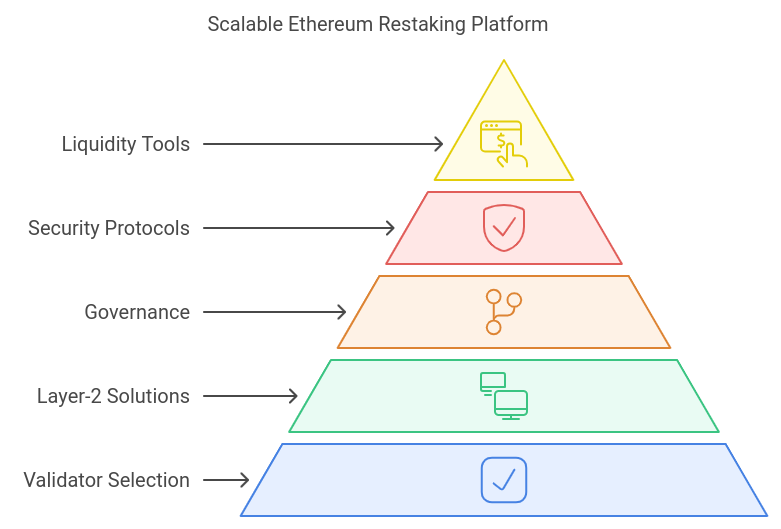
- Validator Selection and Staking Mechanisms
A core element of any Ethereum restaking platform is choosing reliable validators. Validators are crucial for the security and consensus of the Ethereum network, as they confirm transactions and propose new blocks. To build a scalable platform, selecting validators with a strong reputation and proven uptime is essential. Additionally, integrating flexible staking mechanisms that allow easy participation and management of staked assets is important for scalability, ensuring that your platform can handle high volumes of users without performance issues. - Layer-2 Scaling Solutions
Ethereum’s main chain can become congested, particularly with increasing transaction volumes, which can impact the scalability of a restaking platform. Layer-2 solutions, such as Optimistic Rollups and zk-Rollups, offer significant scalability improvements by processing transactions off-chain and settling them later on the main chain. Incorporating these solutions helps reduce gas fees and latency while ensuring the restaking platform can scale to accommodate growth in DeFi projects. These Layer-2 solutions also make it easier to handle complex DeFi interactions, such as liquidity provision, without overwhelming the Ethereum network. - Governance and User Participation
A decentralized governance model is vital for the scalability of a restaking platform. Allowing users to participate in key decisions, such as selecting validators or adjusting staking parameters, fosters community engagement and ensures the platform remains decentralized. Governance protocols such as decentralized autonomous organizations (DAOs) can be integrated to manage key decisions, vote on improvements, and enable more efficient network management. By enabling user participation, the platform becomes more flexible and adaptable to changing conditions in the Ethereum ecosystem. - Security Protocols and Auditing Mechanisms
Ensuring the security of a restaking platform is paramount, especially as staked ETH and DeFi assets are at risk. Implementing strong cryptographic techniques, such as multi-signature wallets and secure key management practices, is essential for safeguarding user funds. Additionally, regular audits by third-party security firms should be part of the platform’s security strategy to identify vulnerabilities early. A robust monitoring and alert system is also necessary to detect and mitigate any potential issues before they affect the platform’s performance or user assets. - Liquidity and Yield Optimization Tools
For Ethereum restaking to be attractive to DeFi projects and users, the platform must provide mechanisms for liquidity optimization and yield enhancement. Restaking platforms can offer various financial products, such as liquidity pools and staking derivatives, that allow users to earn rewards not just from Ethereum staking but also from additional DeFi activities. By integrating automated yield farming strategies and providing liquidity incentives, these platforms can offer higher returns to users, encouraging more participation and increasing the scalability of the platform.
Incorporating these components into a scalable Ethereum restaking platform ensures its ability to handle increasing demand, maintain security, and provide valuable services to the DeFi community.
Steps to Build a Scalable Ethereum Restaking Platform
Building a scalable Ethereum restaking platform involves a series of strategic steps, each designed to ensure that the platform can handle high volumes of activity while maintaining security, performance, and user satisfaction. Below are the steps to create a robust and scalable platform:
Step 1: Understand Ethereum’s Proof-of-Stake and Restaking Mechanism
Before diving into development, it’s essential to fully understand how Ethereum’s Proof-of-Stake (PoS) works, including how restaking integrates into the ecosystem. Ethereum PoS allows validators to secure the network and earn rewards by staking ETH. Restaking extends this concept, enabling ETH stakers to participate in additional DeFi activities, like governance or liquidity provision, while still earning staking rewards. Having a solid understanding of these mechanisms will help in designing a platform that aligns with Ethereum’s consensus and maximizes the potential of restaking.
Step 2: Choose Reliable Validators and Staking Pools
Selecting trustworthy validators is a crucial step. Validators need to be highly available, efficient, and have a history of good performance. The choice of staking pools should also be considered, as some pools might offer better yields or more flexible terms. Additionally, you’ll want to ensure that the platform allows for easy validator selection, transparency on performance, and the ability for users to change validators without friction. This gives users the flexibility and security needed to participate in Ethereum restaking with confidence.
Step 3: Integrate Layer-2 Scaling Solutions
Scalability is a key challenge for any Ethereum-based platform, and restaking is no exception. To handle high transaction volumes and reduce gas fees, integrating Layer-2 scaling solutions like Optimistic Rollups, zk-Rollups, or sidechains is vital. These solutions process transactions off-chain and settle them periodically on the Ethereum mainnet, increasing throughput and reducing the strain on the network. This is especially important as the Ethereum ecosystem grows, ensuring that your platform remains responsive and cost-efficient for users.
Step 4: Develop Governance Mechanisms
To create a decentralized and scalable platform, it is essential to implement a governance model that allows users to actively participate in decision-making. This could involve using a Decentralized Autonomous Organization (DAO) where users can vote on critical aspects, such as validator selection, protocol upgrades, or changes to staking parameters. Decentralized governance ensures that the platform remains flexible, transparent, and responsive to user needs, allowing for scalability without central control.
Step 5: Build Robust Security Protocols
Security is a top priority when building any blockchain-based platform, especially one involving staked assets. Implement robust cryptographic techniques, including multi-signature wallets, secure key management, and advanced encryption methods. Ensure the platform undergoes regular security audits to identify and address vulnerabilities. A strong security framework will protect both user funds and the integrity of the restaking mechanism, allowing the platform to scale without compromising safety.
Step 6: Enable Liquidity and Yield Optimization Tools
For users to find value in your restaking platform, it must provide tools for optimizing liquidity and maximizing yield. This could include integrating yield farming strategies, liquidity pools, and staking derivatives, which enable users to earn additional rewards from their staked ETH. Offering multiple financial products within the platform increases its appeal, allowing it to scale effectively as users seek to maximize their returns while participating in Ethereum restaking.
Step 7: Implement Efficient Monitoring and Analytics
A scalable restaking platform needs to have real-time monitoring and performance analytics. This ensures that any potential issues — such as validator downtime, network congestion, or security breaches — are detected early. Implementing a transparent dashboard that allows users to track their staking performance, rewards, and platform health will foster trust and engagement. Analytics also help in optimizing platform operations, identifying areas for improvement, and providing data-driven insights for governance decisions.
Step 8: Optimize User Experience and Interface (UI/UX)
A scalable platform isn’t just about technical performance; it’s also about ensuring users have an intuitive, seamless experience. A clean, user-friendly interface is essential for attracting and retaining users. The staking process, withdrawal, validator selection, and platform governance should be easy to navigate. Simplified onboarding for new users, detailed tutorials, and transparent information about how restaking works will help drive engagement and grow the user base over time.
Step 9: Monitor Ethereum Network Upgrades
Ethereum’s network is constantly evolving, with upgrades and improvements designed to enhance scalability, security, and overall performance. To ensure the long-term scalability of your restaking platform, it’s important to stay updated on Ethereum’s upgrades (e.g., Ethereum 2.0, EIPs, etc.). Your platform should be designed to adapt to these changes without major disruptions. Implementing a system for automatically upgrading or patching the platform as Ethereum’s infrastructure evolves will ensure the platform remains aligned with the latest network improvements.
Step 10: Launch, Market, and Scale
Once your platform is built, it’s time to launch. Begin with a beta phase to gather feedback from early users, fix any bugs, and optimize performance. Once stable, market the platform to attract a larger user base. Highlight the scalability, security, and yield optimization features in your marketing materials. As the platform grows, continue to scale the infrastructure, add new features, and improve the user experience based on feedback to ensure the platform can handle the increasing demand from the DeFi community.
By following these steps, you can build a scalable, secure, and user-friendly Ethereum restaking platform that empowers DeFi projects and enhances the Ethereum ecosystem.
Tools and Technologies for Building Ethereum Restaking Platforms
Building a scalable and efficient Ethereum restaking platform requires leveraging various tools and technologies that support blockchain interaction, security, and scalability. Below are six essential tools:
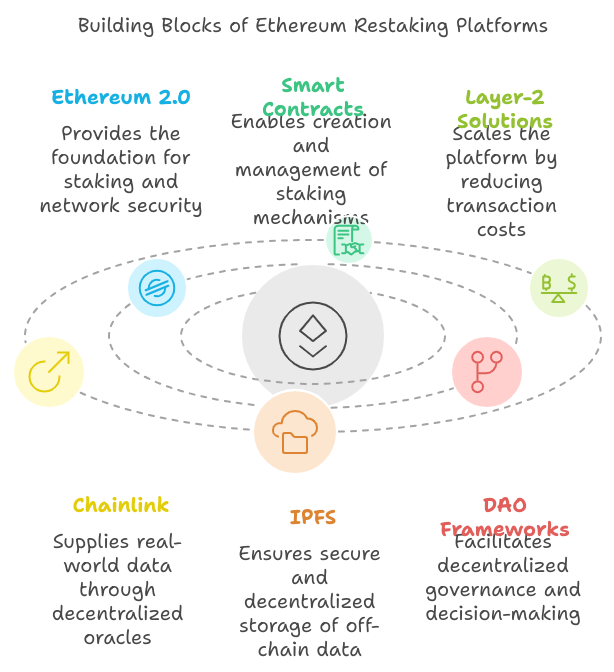
- Ethereum 2.0 (Proof-of-Stake)
Ethereum 2.0 provides the foundation for restaking by allowing validators to stake ETH and earn rewards. Its Proof-of-Stake mechanism is essential for securing the network and enabling restaking features. - Smart Contracts (Solidity)
Solidity is the primary programming language for writing smart contracts on the Ethereum blockchain. It allows developers to create and manage staking pools, validator selection mechanisms, and yield farming protocols. - Layer-2 Solutions (Optimistic Rollups, zk-Rollups)
Layer-2 solutions such as Optimistic Rollups and zk-Rollups help scale Ethereum-based platforms by processing transactions off-chain and reducing gas fees, enabling higher throughput for restaking activities. - Chainlink
Chainlink provides decentralized oracles that are critical for fetching real-world data for restaking platforms, such as validator performance, staking rewards, and on-chain governance updates. - IPFS (InterPlanetary File System)
IPFS allows decentralized storage for off-chain data, ensuring that platform records and user interactions are secure and easily accessible while maintaining decentralization. - DAO Frameworks (Aragon, Compound)
DAO frameworks like Aragon and Compound enable decentralized governance within the restaking platform, allowing users to participate in decision-making for validator selection and protocol changes.
These tools collectively enhance the functionality, security, and scalability of Ethereum restaking platforms.
Testing and Optimization for Ethereum Restaking Platforms
Testing and optimization are crucial steps in building a reliable and scalable Ethereum restaking platform. By ensuring the platform’s performance, security, and user experience are up to standard, you can avoid costly failures and ensure long-term success. Here are key aspects to consider:
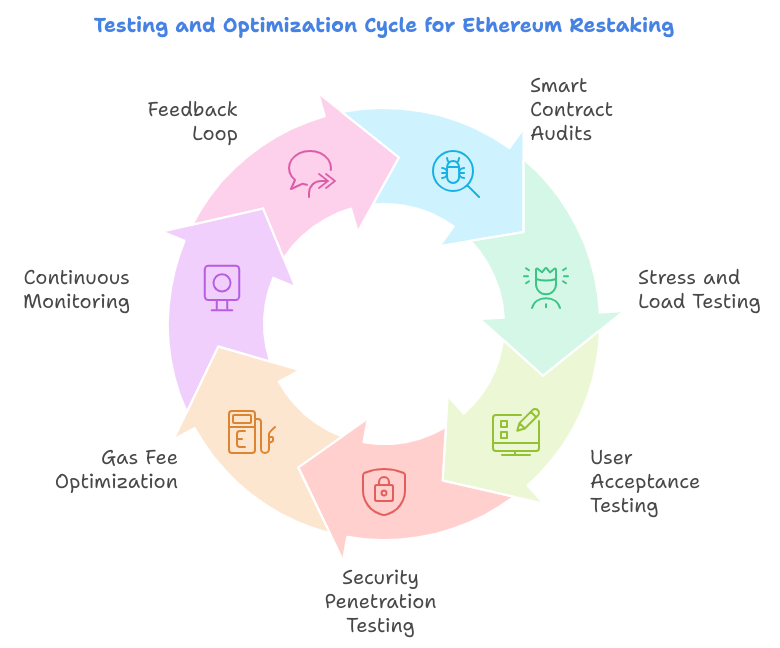
1. Smart Contract Audits
Before launching any Ethereum-based platform, thorough auditing of smart contracts is essential. These audits help detect vulnerabilities, such as reentrancy attacks or logic errors, that could jeopardize the security of user funds or the platform’s operations. Engaging third-party security firms to conduct comprehensive audits ensures that smart contracts are safe, efficient, and compliant with best practices.
2. Stress Testing and Load Testing
Stress and load testing help simulate high-traffic conditions on the platform, identifying bottlenecks or performance issues before they impact real users. By testing the scalability of the restaking platform under heavy usage, you can ensure the platform can handle large numbers of transactions, particularly during peak periods, without downtime or delays.
3. User Acceptance Testing (UAT)
User Acceptance Testing ensures the platform meets the needs and expectations of end users. By having real users test the platform in a controlled environment, you can identify any usability issues, clarify documentation, and ensure a smooth onboarding process. This phase also validates that all features, including staking, liquidity optimization, and governance mechanisms, function as expected.
4. Security Penetration Testing
Penetration testing (or ethical hacking) is essential to identify potential attack vectors and weaknesses in the platform. A team of security experts will simulate various attack scenarios, such as DDoS attacks, smart contract exploits, or network breaches, to test the platform’s resilience. This testing helps in fortifying the platform against real-world attacks before going live.
5. Gas Fee Optimization
Ethereum transactions often incur high gas fees, which can be a barrier to entry for users. By optimizing smart contracts and integrating Layer-2 solutions, you can reduce gas costs and improve the overall cost-effectiveness of your platform. Techniques such as batching transactions and minimizing on-chain operations can help lower gas usage while maintaining functionality.
6. Continuous Monitoring and Bug Fixing
Once the platform is live, continuous monitoring is necessary to ensure its ongoing performance and security. Implementing monitoring tools that track validator uptime, transaction throughput, and platform health can help detect issues before they affect users. Additionally, having a dedicated team for prompt bug fixes and updates will maintain the platform’s performance as the Ethereum network evolves.
7. Feedback Loop for Continuous Improvement
After launching the platform, it is essential to set up a feedback loop with users. Collecting user feedback on their experience and issues encountered helps in prioritizing updates and optimizations. Additionally, monitoring the Ethereum network and staying up-to-date with protocol updates or new Ethereum developments ensures that your restaking platform remains optimized in line with the broader ecosystem changes.
By incorporating these testing and optimization practices, you ensure that your Ethereum restaking platform can scale efficiently, stay secure, and provide a positive user experience.
Ensuring Platform Security and Scalability
Building a secure and scalable Ethereum restaking platform is critical for long-term success, as it involves managing sensitive user funds and handling high transaction volumes. Here’s how to address both aspects effectively:
Ensuring Security:
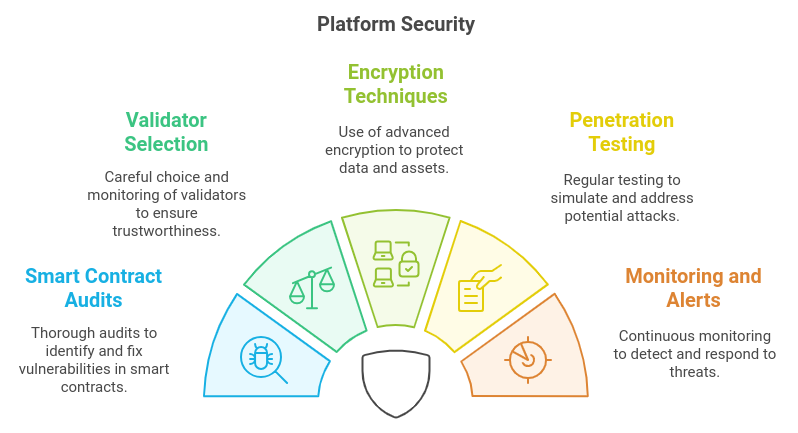
- Robust Smart Contract Audits
Security starts with thoroughly audited smart contracts. Engage reputable third-party firms to identify vulnerabilities, such as reentrancy attacks, logic errors, or misconfigured permissions. Regular audits ensure that the platform’s codebase is resilient to potential exploits. - Secure Validator Selection
Use transparent and stringent criteria for choosing validators. Monitor their performance, ensure redundancy, and implement slashing mechanisms to penalize bad actors. Decentralized governance can help users collectively decide on trusted validators. - Advanced Encryption Techniques
Employ strong encryption protocols to protect user data and assets. Multi-signature wallets, zero-knowledge proofs, and hardware security modules (HSMs) enhance the platform’s defense against unauthorized access. - Regular Security Penetration Testing
Conduct penetration tests to simulate real-world attack scenarios, such as DDoS attacks or protocol exploits. These tests identify vulnerabilities, enabling preemptive fixes to safeguard the platform. - Real-Time Monitoring and Alerts
Implement monitoring systems to track platform activity, validator performance, and staking pool health. Alerts for unusual activity, like validator downtime or large asset movements, enable quick responses to potential threats.
Ensuring Scalability:
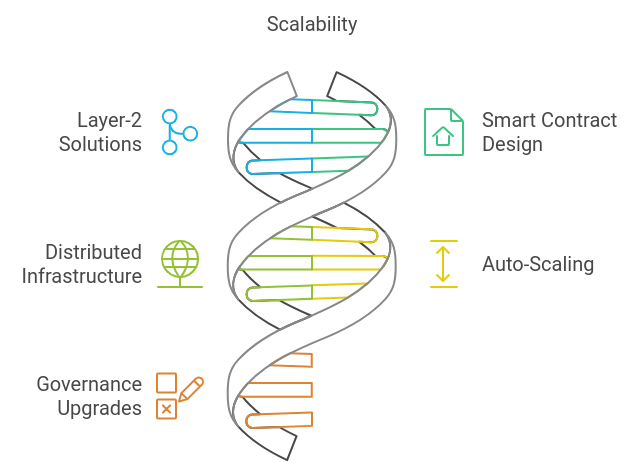
- Layer-2 Solutions Integration
Reduce Ethereum mainnet congestion and gas fees by integrating Layer-2 scaling solutions such as Optimistic Rollups or zk-Rollups. These technologies enhance throughput while maintaining security through periodic mainnet settlements. - Efficient Smart Contract Design
Optimize smart contracts to reduce computational complexity and gas costs. Techniques like batching transactions, reducing state changes, and utilizing efficient storage methods minimize resource consumption. - Distributed Infrastructure
Use decentralized and distributed infrastructure, such as IPFS for data storage and blockchain indexing services, to prevent bottlenecks and ensure platform availability during traffic spikes. - Auto-Scaling Capabilities
Implement cloud-based auto-scaling mechanisms to dynamically adjust resources based on user demand. This ensures consistent performance, even during peak traffic periods. - Governance-Driven Upgrades
Decentralized governance mechanisms allow the community to propose and vote on scalability enhancements, such as validator expansion or protocol optimizations. This ensures the platform evolves in line with user needs.
By focusing on these strategies, you can build an Ethereum restaking platform that is both secure and scalable, meeting user demands while safeguarding their assets.
Adapting to Ethereum’s Future Upgrades
Ethereum’s ecosystem is continually evolving, with regular upgrades designed to improve scalability, security, and efficiency. For a scalable Ethereum restaking platform to thrive, it must adapt seamlessly to these updates. Here’s how platforms can prepare for and incorporate future Ethereum upgrades:
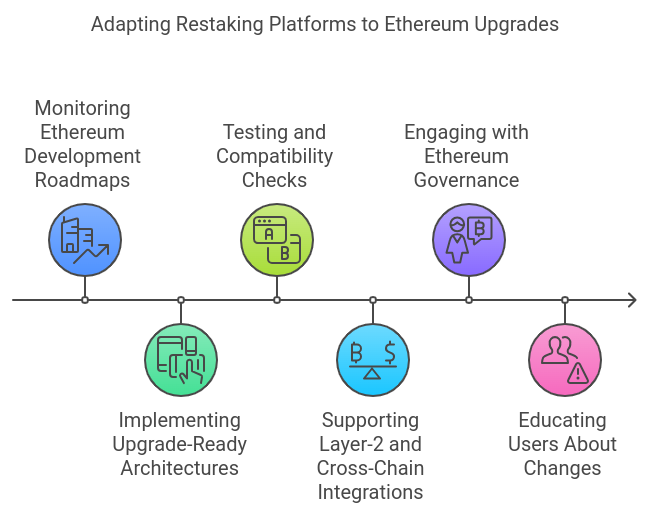
1. Monitoring Ethereum Development Roadmaps
Staying informed about Ethereum’s planned upgrades, such as upcoming Ethereum Improvement Proposals (EIPs), is essential. Platforms should actively monitor updates from Ethereum core developers, GitHub repositories, and the Ethereum Foundation to anticipate changes like changes to gas fee structures, consensus mechanisms, or Layer-2 advancements.
2. Implementing Upgrade-Ready Architectures
Designing a flexible architecture that can accommodate future upgrades without major overhauls is crucial. By using modular development practices, platforms can isolate components like staking mechanisms, smart contracts, and governance protocols. This makes it easier to update specific features or integrate new functionalities introduced by Ethereum upgrades.
3. Testing and Compatibility Checks
Before deploying updates, platforms should conduct thorough compatibility testing with new Ethereum protocols. For instance, changes to Ethereum’s Virtual Machine (EVM) or consensus layer can impact smart contract functionality. Regular testing ensures that the platform remains operational and secure post-upgrade.
4. Supporting Layer-2 and Cross-Chain Integrations
As Ethereum progresses, Layer-2 solutions and cross-chain capabilities will play a significant role in its ecosystem. Restaking platforms should proactively integrate popular scaling solutions like zk-Rollups and Optimistic Rollups while exploring cross-chain staking options to broaden their user base and enhance scalability.
5. Engaging with Ethereum Governance
Participating in Ethereum’s decentralized governance processes allows platforms to influence upgrades and stay ahead of ecosystem shifts. Active engagement ensures that restaking platforms can advocate for changes that benefit their operations and adapt their strategies in alignment with the broader Ethereum community.
6. Educating Users About Changes
User education is vital when upgrades bring significant changes, such as alterations to staking rules or new Layer-2 implementations. Providing clear documentation, tutorials, and updates ensures that users understand how the platform adapts to Ethereum’s upgrades and continue to use it confidently.
By preparing for Ethereum’s future upgrades and maintaining adaptability, a restaking platform can remain competitive, secure, and aligned with the Ethereum ecosystem’s growth.
Conclusion
Building a scalable Ethereum restaking platform is a multifaceted process that requires careful planning and execution. By focusing on key areas like selecting reliable staking validators, implementing efficient consensus mechanisms, and leveraging layer-2 solutions, developers can enhance the security and scalability of their DeFi projects. Additionally, integrating governance models and monitoring mechanisms ensures that the platform remains adaptable to future developments in the Ethereum ecosystem.
As Ethereum continues to evolve, restaking will play a pivotal role in maximizing the potential of DeFi projects. By adopting best practices and staying aligned with Ethereum’s upgrades, developers can create platforms that not only provide value today but are also prepared for the challenges of tomorrow. Building a scalable Ethereum restaking platform ensures long-term success in the DeFi space, enabling projects to thrive in an increasingly decentralized and competitive landscape.
FAQs
- What is Ethereum Restaking, and how does it benefit DeFi projects?
Ethereum Restaking allows projects to leverage staked ETH to improve network security and generate additional yields, enhancing the sustainability of DeFi platforms. - What are the key components required to build a scalable Ethereum restaking platform?
Key components include selecting reliable validators, utilizing layer-2 scaling solutions, integrating staking mechanisms, and incorporating governance protocols. - How can I ensure the security of my Ethereum restaking platform?
Ensure platform security by selecting trustworthy staking validators, implementing strong encryption methods, and adopting best practices for monitoring and auditing. - What role do layer-2 solutions play in Ethereum restaking?
Layer-2 solutions help scale Ethereum transactions by reducing congestion on the main chain, improving throughput, and reducing costs, which is essential for scalability. - How does Ethereum’s Proof-of-Stake consensus model relate to restaking?
Ethereum’s PoS model allows staked ETH to be used for both securing the network and participating in additional decentralized activities, such as restaking for DeFi.
How to Build a Scalable Ethereum Restaking Platform for DeFi Projects? was originally published in The Capital on Medium, where people are continuing the conversation by highlighting and responding to this story.

 2 months ago
41
2 months ago
41

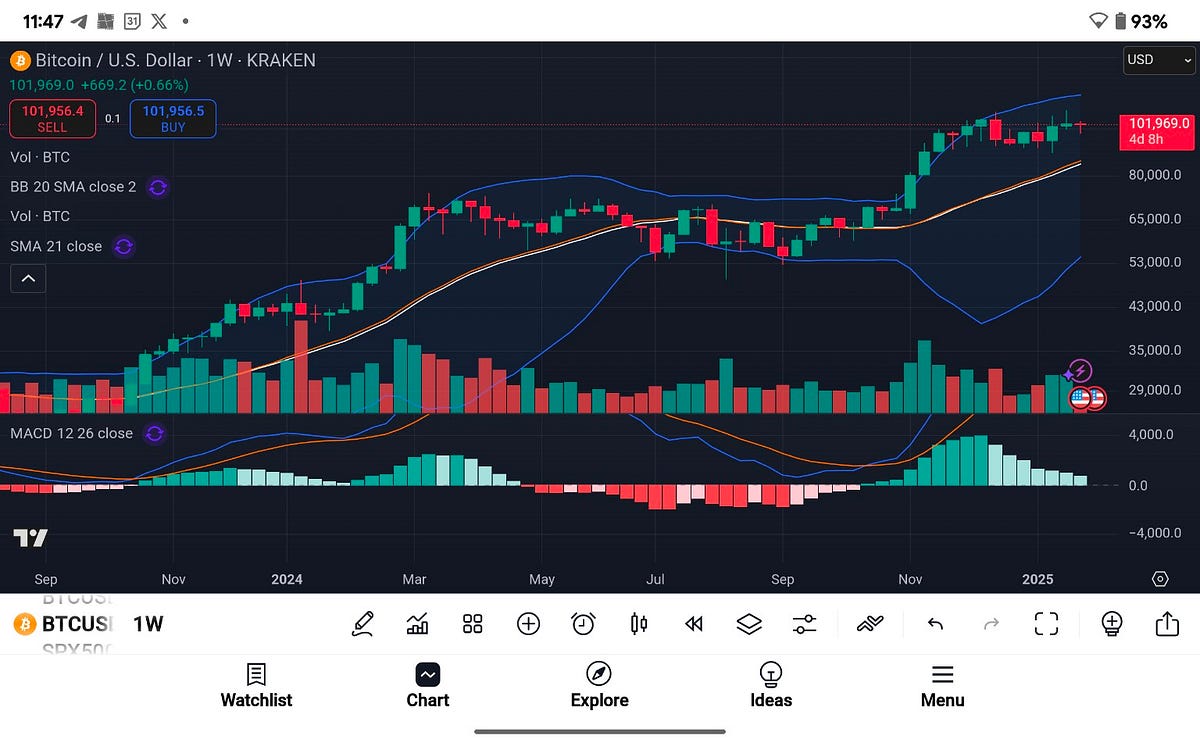







 English (US) ·
English (US) ·